Root cellars provide you with nature's perfect apple storage solution, maintaining ideal temperatures between 32-40°F and humidity levels of 85-95% without electricity. You'll find these underground spaces naturally regulate temperature and moisture year-round, creating the cool, dark environment that apples need to stay fresh for months. The earth's insulation helps prevent temperature fluctuations, while proper ventilation systems manage ethylene gas and prevent spoilage. When you arrange your apples in single layers with good airflow, you're using the same time-tested methods that have preserved harvests for generations. Discover why this traditional storage method remains unmatched for long-term apple preservation.
Natural Temperature Control Systems
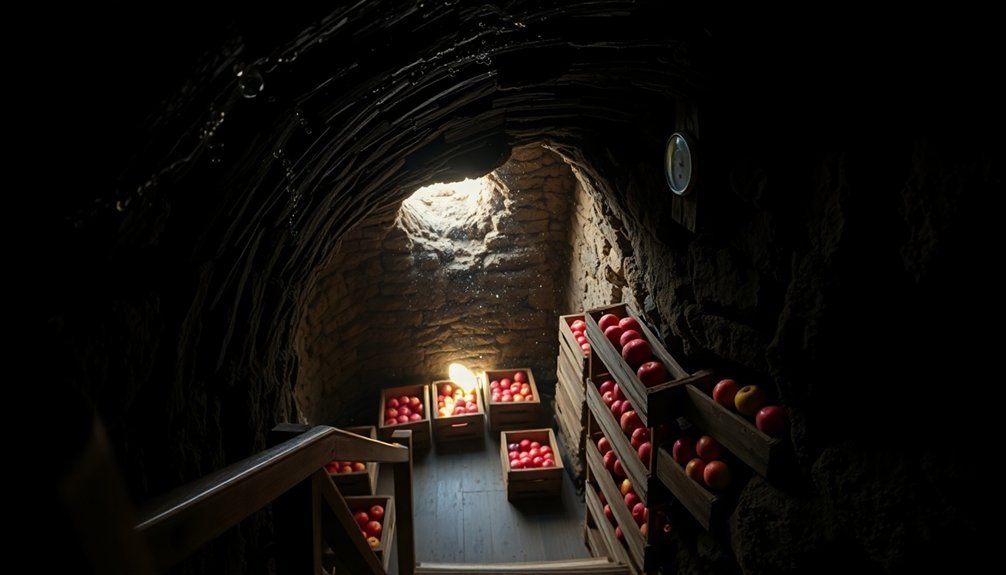
Most root cellars rely on the earth's natural insulation and strategic design to maintain suitable storage temperatures between 32-40°F (0-4°C).
You'll find this temperature range is vital for your apples, as it slows down ethylene gas release and prevents premature decay. If temperatures rise above 40°F, you'll notice faster spoilage and potential sprouting issues.
To achieve best temperature control, you'll want to position your root cellar on a north-facing slope or in a shaded area where direct sunlight won't affect the internal temperature. Regular temperature monitoring is essential for maintaining optimal storage conditions.
Building below the frost line is essential, as it protects your stored apples from freezing during winter months. You can enhance the earth's natural insulating properties by adding straw bales or foam board insulation.
Your ventilation system plays a significant role in maintaining consistent temperatures.
You'll need to manage air circulation through adjustable vents or exhaust pipes, particularly during nighttime when cooler air can naturally lower the cellar's temperature.
During extreme weather conditions, you'll need to monitor and adjust these vents to prevent freezing.
In regions with varying climates, you might need to adapt your ventilation strategy seasonally to maintain suitable storage conditions.
Maintaining Ideal Humidity Levels
You'll need to maintain high humidity levels between 80-95% RH to prevent your apples from shriveling and losing quality during storage.
Creating the right moisture balance requires consistent monitoring with a hygrometer and quick adjustments when conditions change.
You can use natural methods to boost humidity, such as placing damp sand beneath the apples or hanging moistened burlap sacks on your cellar walls.
Maintaining good air circulation throughout your root cellar helps prevent excess moisture from causing mold growth while keeping humidity levels optimal.
Moisture Balance Essentials
Maintaining proper humidity levels is the cornerstone of successful apple storage in your root cellar. You'll need to keep the relative humidity between 80-95%, with 90-95% being best for preventing dehydration and extending shelf life. This high moisture environment slows down respiration and natural decay, helping your apples stay crisp and flavorful. Good ventilation helps remove harmful ethylene gas that can accelerate ripening.
To achieve the right moisture balance, you'll need to monitor and adjust conditions regularly using a hygrometer. When humidity drops too low, your apples will shrivel and lose quality. Conversely, excessive moisture without proper ventilation can lead to mold growth.
| Humidity Level | Effects on Apples |
|---|---|
| 90-95% RH | Best preservation, longest shelf life |
| 85-89% RH | Good storage, minimal moisture loss |
| 80-84% RH | Acceptable but may cause slight shriveling |
| Below 80% RH | Significant dehydration and quality loss |
| Above 95% RH | Risk of mold growth without ventilation |
You can maintain ideal humidity by misting the storage space when needed and ensuring proper airflow. Remember to check humidity levels regularly and adjust ventilation to prevent moisture from becoming trapped, which could compromise your apple storage success.
Natural Humidity Control Methods
Four natural methods provide reliable humidity control in your root cellar without requiring modern equipment. Start with a dirt and gravel floor foundation, which naturally retains moisture and allows you to adjust humidity levels by simply sprinkling water when needed. The gravel layer helps keep your feet dry while maintaining consistent moisture levels throughout the space.
You'll find that water and damp materials offer flexible humidity control options. Place pans of water on the floor for natural evaporation, or drape damp burlap bags over your produce. For specific vegetables, you can use damp sawdust, sand, or moss as packing materials to reduce moisture loss through surface evaporation.
Consider using sealed or perforated containers to create controlled micro-climates. These storage solutions, similar to grocery store potato containers, help maintain ideal moisture levels for different produce types while preventing excessive water loss.
Don't forget about proper ventilation – it's essential for managing humidity. You'll need to adjust air intake and guarantee good circulation between stored items. This prevents condensation buildup while removing ethylene gas and unwanted odors, maintaining the perfect environment for your stored apples.
Essential Air Circulation Methods
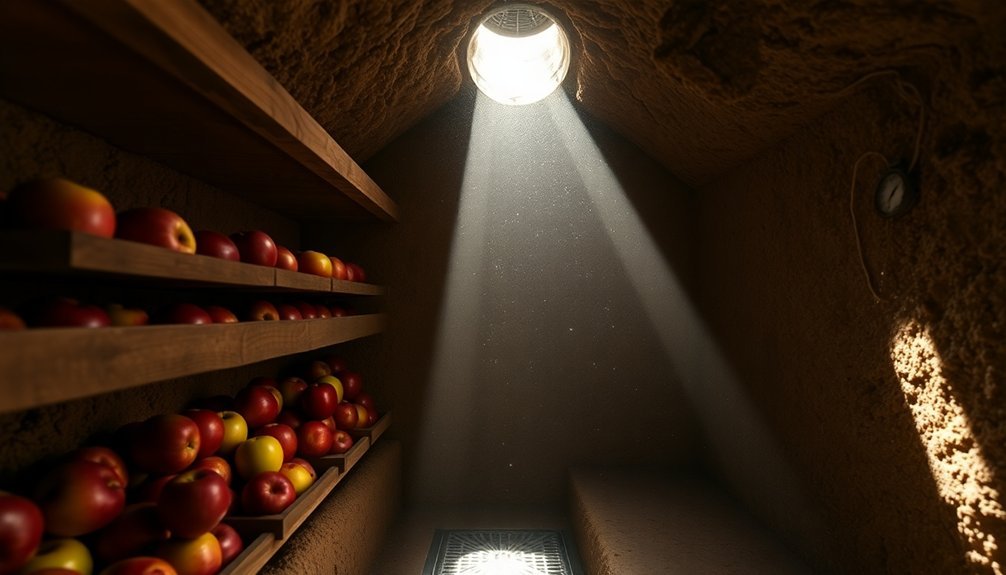
You'll need a well-designed natural airflow system with inlet vents near the floor and outlet vents near the ceiling to keep your stored apples fresh.
Position your ventilation ports on opposite walls, using 3-4 inch diameter openings that allow cool air to enter low and warm air to exit high for ideal circulation.
When natural airflow isn't sufficient, you can install multi-level fans strategically throughout your root cellar to maintain consistent air movement and prevent stagnant pockets that could lead to spoilage.
Natural Air Flow Systems
A well-designed natural air flow system serves as the backbone of any successful root cellar. You'll find that proper ventilation relies on the basic principle of convection, where cold air naturally sinks while warm air rises. By installing vents at different heights, you're creating a passive system that doesn't require mechanical assistance.
| Component | Function | Benefits |
|---|---|---|
| Lower Vents | Allow cold air entry | Maintains cool temperatures |
| Upper Vents | Release warm air | Prevents heat buildup |
| Sealable Covers | Control airflow | Adapts to seasonal changes |
| Natural Convection | Creates air movement | No energy costs |
| Temperature Monitor | Tracks conditions | Guarantees ideal storage |
You'll need to position your vents strategically to maximize this natural flow. The incoming air helps maintain proper humidity levels while removing ethylene gas that apples naturally produce. When you're planning your cellar, verify the vents can be sealed during extreme weather conditions. During winter months, you might need to close the vents partially to prevent freezing, while in warmer periods, you'll want them fully open to maintain coolness. This passive system works best when combined with proper insulation and drainage.
Ventilation Port Placement
Proper ventilation port placement consistently ranks as the most critical factor in root cellar design.
You'll need to position your intake vents low to the ground where cool air naturally settles, while placing outlet vents high up near the ceiling to allow warm air to escape. This strategic placement creates a natural chimney effect that promotes constant air circulation.
To maximize airflow, you'll want to install vents on opposite sides of your cellar. If possible, opt for vertical ventilation with an outlet vent through the ceiling or roof, as this creates the strongest upward air movement.
If vertical ventilation isn't feasible, horizontal ventilation using opposing walls will still improve air circulation.
Don't forget to properly seal your vents with materials like expanding foam or rubber gaskets so you can close them tightly during winter. You'll also need screens to prevent pest intrusion.
For ideal performance, keep your vents open during summer nights to let in the coolest air possible.
Remember to elevate your apple crates a few inches off the floor – this simple step allows air to circulate underneath, reducing moisture buildup and preventing spoilage.
Multi-Level Fan Strategies
Effective root cellar ventilation relies on three essential air circulation methods: natural convection, mechanical fans, and strategic vent placement.
When you're designing your root cellar's ventilation system, you'll need to work with natural convection principles. Cool air enters through your low intake vents while warm air naturally rises to exit through high outlet vents, creating a continuous circulation cycle without mechanical assistance.
You'll find this passive system particularly effective in maintaining consistent temperatures and humidity levels.
To enhance this natural airflow, you'll want to incorporate vertical vent stacks that extend through the ceiling or roof. These stacks maximize the upward movement of warm air and help force out excess moisture and ethylene gas.
You'll need to guarantee a proper balance between intake and outlet vents to maintain ideal air exchange.
Don't forget to adjust your vents seasonally. You'll want to seal them during winter to maintain cold temperatures and open them during summer to release warm air.
This seasonal adjustment prevents extreme temperature fluctuations and helps maintain perfect storage conditions for your apples year-round.
Root Cellar Construction Requirements
Building a root cellar requires four essential construction elements: site preparation, solid foundation work, proper insulation, and strategic ventilation.
You'll need to start by digging into a hillside or underground, ensuring the footer sits below the frost line to prevent freezing. Level the ground and add gravel for proper drainage around the foundation.
For the foundation, you'll pour a concrete footer that's either 16 inches wide for block walls or 8 inches wide for poured concrete walls. Don't forget to incorporate reinforcing rods, especially near the door area. Your walls should be built using moisture-resistant materials like concrete blocks or bricks.
The insulation system calls for 2-inch layers of extruded polystyrene foam on interior surfaces, covered with mold-resistant materials.
You'll need to install two vents – one at ground level and another at ceiling height – to maintain proper air circulation. For the roof, construct an arch rather than a flat surface to manage condensation effectively. Cover it with plywood, plastic sheeting, and additional insulation before adding 2-4 feet of soil.
Remember to leave a 2-inch gap between storage shelves and walls for air movement.
Proper Apple Storage Arrangements
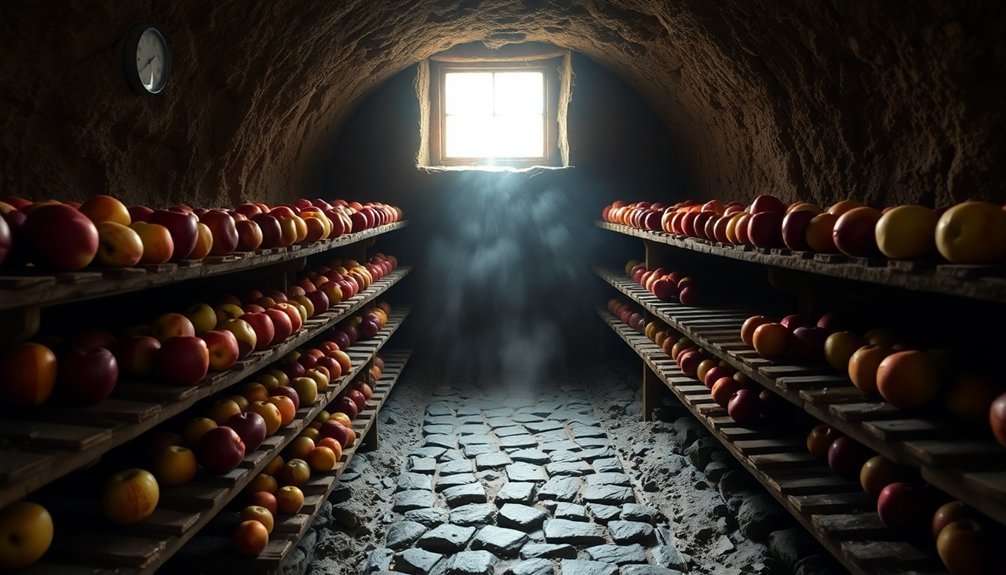
Mastering apple storage begins with understanding the precise conditions needed for long-term preservation. You'll want to maintain temperatures between 32 and 40 degrees F, along with 85-95% relative humidity in a consistently dark environment. These conditions are vital for maximizing your apples' shelf life.
When arranging your apples, it's important to prevent them from touching each other. You can create single layers separated by newspaper, kraft paper, straw, or clean dry leaves. Using boxes, barrels, or buckets with proper ventilation will help protect your fruit while preventing mold growth.
If you're storing large quantities, consider building custom orchard racks or repurposing produce containers.
Choose your apple varieties wisely, as some store better than others. Honeycrisp can last over a year, while Stayman-Winesap, York Imperial, and Arkansas Black Twig will keep for at least six months.
Remember to check your stored apples regularly for signs of spoilage and remove any affected fruit immediately. You'll also want to use larger apples first, as they tend to soften more quickly than smaller ones.
Keep your apples isolated from other produce, particularly potatoes, turnips, and cabbage, to prevent premature ripening.
Ethylene Gas Management
Proper management of ethylene gas stands out as one of the most vital aspects of apple storage. Since apples are high producers of ethylene gas, you'll need to take specific measures to prevent premature ripening and spoilage of other stored produce. By placing your apples on upper shelves near vents, you'll help facilitate the natural escape of ethylene gas from your root cellar.
You'll want to install at least two screened vents – one for intake and one for exhaust – to maintain proper air circulation and manage ethylene gas buildup. Make certain you're storing your apples separately from ethylene-sensitive vegetables, either in sealed containers or on dedicated shelves. This separation is essential for preventing unwanted ripening of nearby produce.
Regular monitoring of your storage area is significant. You should check for any signs of spoilage daily and remove decaying apples promptly to prevent further contamination.
Keep your root cellar well-organized, with ethylene-producing items distinctly separated from sensitive ones. You'll also need to maintain consistent temperature and humidity levels to slow down ethylene gas production and guarantee ideal storage conditions for your apples.
Traditional Storage Container Options
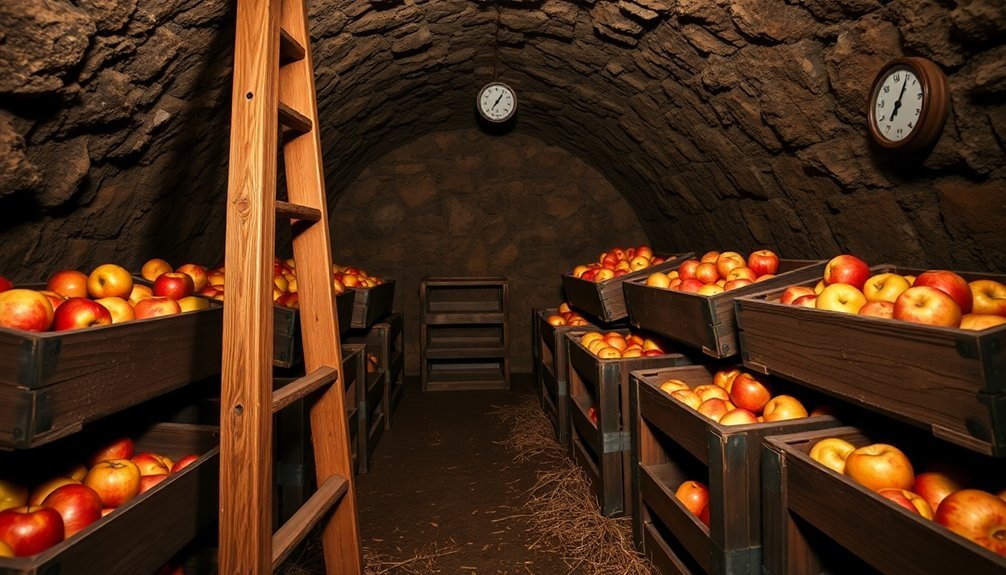
Once you've set up proper ethylene gas management, selecting the right storage containers becomes your next key consideration. You'll find several traditional options that can effectively preserve your apple harvest while maximizing your available space.
| Container Type | Key Features | Best Use Case |
|---|---|---|
| DIY Racks | Customizable size, wooden construction, sliding drawers | Large harvests in limited space |
| Wooden Boxes | Portable, handled, multiple sizes | Small batches and gift packaging |
| Root Cellar Crates | Blanket coverage option, well-ventilated | Long-term basement storage |
| Commercial Racks | Pre-made, durable materials, systematic design | Professional storage needs |
You'll want to choose containers that match your storage volume and space constraints. If you're storing apples in your basement or root cellar, consider building your own wooden storage racks with sliding drawers. They're cost-effective and can be customized to fit your space perfectly. For smaller quantities, wooden boxes offer great portability and versatility. If you're using a root cellar, traditional crates combined with proper shelving will serve you well – just remember to drape heavy blankets over them to maintain ideal dark conditions. Commercial racks are worth considering if you need a ready-made solution that's built to last.
Long-Term Preservation Benefits
The impressive benefits of root cellar storage can extend your apples' shelf life up to 8 months while preserving their crisp texture and nutritional value.
You'll find that root cellars provide ideal environmental conditions, maintaining a steady temperature around 55 degrees Fahrenheit and high humidity levels that protect your fruit from deterioration.
Root cellars excel at managing ethylene gas, which apples naturally produce during ripening. You can maximize storage effectiveness by separating apples from other produce, especially pears, and removing any damaged fruit promptly.
The cellar's good air circulation helps dissipate this gas, preventing premature ripening of your stored produce.
You'll appreciate how root cellars preserve your apples' quality by maintaining their vibrant color, crisp texture, and natural flavor.
The cool, dark environment slows down metabolic processes, helping retain nutritional content throughout storage.
To achieve the best results, store your apples in single layers using well-ventilated containers, and check regularly for signs of spoilage.
Common Issues and Their Fixes
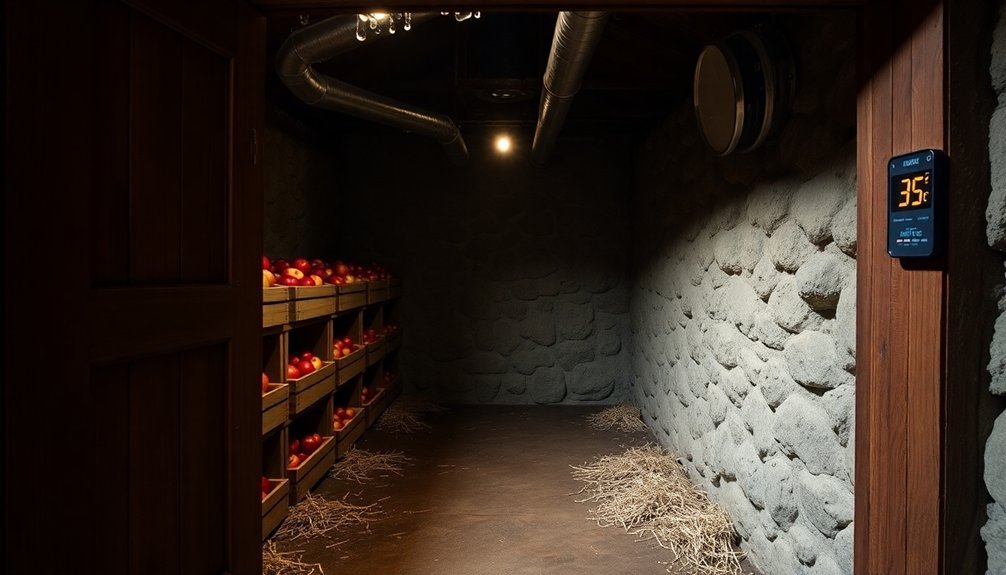
Despite careful planning, root cellar storage can present several common challenges that need immediate attention. If you notice your apples shriveling, you'll need to increase humidity levels to 90-95%. You can achieve this by placing damp sand or straw in your cellar or hanging moistened burlap sacks on the walls.
When you're storing both apples and pears, keep them separated to prevent premature ripening. Apples produce high levels of ethylene gas, which can speed up the ripening process of nearby fruits. Guarantee proper ventilation to remove excess ethylene and prevent gas buildup in your cellar.
Temperature fluctuations can quickly compromise your apple storage. You'll want to maintain temperatures between 32-40°F (0-4°C) consistently. If your apples are going soft, check your temperature control system and make necessary adjustments. Regular monitoring helps prevent these issues before they become severe.
To combat mold and spoilage, inspect your stored apples frequently and remove any damaged fruits immediately. You can use materials like newspaper or sawdust to absorb excess moisture.
Remember that proper airflow is essential – adjust ventilation as needed to prevent mold growth while maintaining ideal humidity levels.
Frequently Asked Questions
How Many Apples Can a Typical Root Cellar Store at Once?
You'll be able to store several hundred to over a thousand apples in your typical root cellar, depending on its size and how well you've organized the space with proper shelving and storage containers.
Do Different Apple Varieties Require Different Storage Zones Within a Root Cellar?
You don't need different zones for apple varieties in your root cellar. All storage-friendly apples thrive in the same conditions: 30-40°F temperature, 90-95% humidity, and darkness. Just keep them in single layers.
Can Root Cellars Be Used in Warm Climate Regions Effectively?
You can use root cellars in warm climates if you bury them deeply, build into hillsides, and install proper ventilation systems. You'll need extra insulation and carefully placed vents to maintain cool temperatures.
How Long Does It Take to Establish Optimal Conditions Initially?
You'll need 2-4 weeks to establish ideal conditions in your root cellar. It takes time to stabilize temperature, humidity, and ventilation after initial setup. Regular monitoring helps guarantee everything's working correctly.
What's the Estimated Annual Cost Savings Compared to Refrigerated Storage?
You'll save between $150-500 annually using a root cellar instead of refrigerated storage. The biggest savings come from reduced energy costs ($100-300) and lower maintenance expenses ($50-200) throughout the year.
In Summary
You'll find that root cellars provide the perfect environment for storing apples through their natural ability to maintain consistent cool temperatures and appropriate humidity levels. When you've properly set up air circulation and ethylene gas management systems, your apples can last for months. Remember to check your storage containers regularly and address any humidity or ventilation issues quickly to prevent spoilage and guarantee your apples stay fresh throughout the storage period.

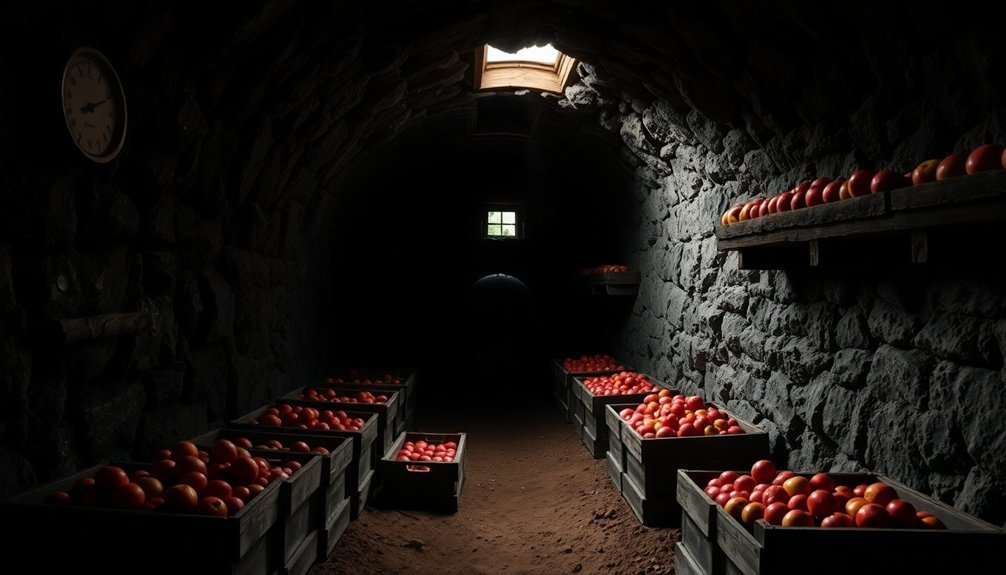



Leave a Reply